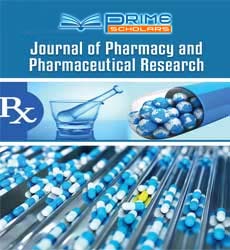Commentary - (2022) Volume 6, Issue 4
Pharmacokinetics is Portrayed as the Examination of the Strong Advancements of New Manufactured Substances
Desai Mahfouz*
Department of Pharmacy, University of Fedral, Brazil
*Correspondence:
Desai Mahfouz,
Department of Pharmacy, University of Fedral,
Brazil,
Email:
Received: 01-Aug-2022, Manuscript No. IPIPR-22-14275;
Editor assigned: 03-Aug-2022, Pre QC No. IPIPR-22-14275 (PQ);
Reviewed: 17-Aug-2022, QC No. IPIPR-22-14275;
Revised: 22-Aug-2022, Manuscript No. IPIPR-22-14275 (R);
Published:
29-Aug-2022, DOI: 10.21767/ipipr.6.4.16
Description
Pharmacokinetics is utilized to portray the ingestion, conveyance,
digestion, and discharge of a compound. Albeit preclinical examinations
require the assurance of satisfactory in vitro action and
pharmacokinetics in somewhere around two creature species,
pharmacokinetic concentrates on should be acted in man to associate
blood focuses with specific organic impacts. Information
on attitude in vivo is expected to tailor alterations to determine
semisynthetic medications in the long run. Pharmacokinetic investigations
of normal items are testing since they commonly include
the organization of perplexing combinations of substances, in
many occasions of obscure parts. A few Chinese prescriptions including
Danshen (Salvia miltiorrhiza), Kang-lai-te (Coix lachryma),
and Ginkgo bilboa have been assessed in randomized controlled
clinical preliminaries. Numerous pharmacokinetic boundaries, especially
of toxins, have not set in stone as even in vitro examinations
are ruined by the outrageous harmfulness of certain toxic
substances, for example, palytoxin.
Pharmacokinetics might be characterized as the investigation of
the powerful developments of unfamiliar synthetic substances (xenobiotics)
during their entry through the body and as such include
the energy of ingestion, circulation, and biotransformation/digestion
and discharge (ADME). It can essentially be portrayed as how
the body handles xenobiotics. Pharmacokinetics utilizes numerical
conditions (models) to portray the time course of ADME of xenobiotics
in the body empowering us to all the more likely comprehend,
decipher and try and anticipate the nature and the degree
of the natural impacts (remedial or harmful) of xenobiotics. A few
methodologies are utilized in pharmacokinetic to depict the destiny
of xenobiotics in the body, including considering the body as
at least one homogenous compartments dependent either upon
numerical fitting or physiological properties. Portrayal of the paces
of the development of xenobiotics into tissue(s) permits better understanding and forecast of the destiny of xenobiotics inside
the body. This article will acquaint the peruse with fundamental
ideas and standards of pharmacokinetic examination utilizing both
compartmental and physiologically based models. Pharmacokinetics
is worried about the exact assurance of the extent of the autonomous
variable in pharmacology and therapeutics, specifically,
the grouping of medication in the body at the natural objective of
interest. The two primary autonomous boundaries in pharmacokinetics
are drug leeway and volume of appropriation; from these,
the third significant boundary of half-life not entirely set in stone.
Leeway is chiefly hepatic or renal; hepatic freedom is evaluated by
regarding the liver as a virtual protein.
Conclusion
Pharmacokinetics is the part of pharmacology managing how medications
arrive at their site of action are taken out from the body.
The accompanying cycles administer the pace of aggregation and
expulsion of medication from a living being assimilation, dispersion,
digestion, and discharge. Drug biotransformation-There is an
expanded interest in the substance changes in a medication once
it enters the body. Much of the time, these medication biotransformation
responses produce intermediates with less pharmacologic
movement than the parent compound; in any case, some
medication metabolites have critical pharmacologic activity.
Acknowledgement
The author is grateful to the journal editor and the anonymous
reviewers for their helpful comments and suggestions.
Conflict of Interest
The author declared no potential conflicts of interest for the research,
authorship, and/or publication of this article.
Citation: Mahfouz D (2022) Pharmacokinetics is Portrayed as the Examination of the Strong Advancements of New Manufactured
Substances. J Pharm Pharm Res. 6:16.
Copyright: © 2022 Mahfouz D. This is an open-access article distributed under the terms of the Creative Commons Attribution
License, which permits unrestricted use, distribution, and reproduction in any medium, provided the original author and source
are credited.

